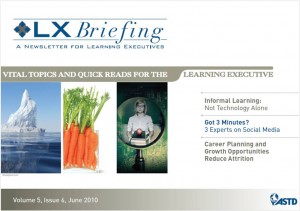 Let me ask you this. What do you feel makes an organization cutting edge when it comes to a learning and development strategy?
Let me ask you this. What do you feel makes an organization cutting edge when it comes to a learning and development strategy?
Recently, I was asked this question in an interview. This question came up because they asked my why I listed Twitter, Facebook and LinkedIn among my learning technology experience. The answer of course goes deeper than having the latest and greatest technology or the best classroom. Companies that invest in informal learning are shown to have sustainable results. Informal learning goes beyond tangible and moves into areas we have not traditionally had much success measuring. That said, it definitely becomes an other stitch woven into the fabric of the organization’s culture for sustainability.
 An article I read recently suggests if learning is an iceberg, then formal learning, such as the classroom, is the tip above the waterline (REF: BENEATH THE SURFACE, ASTD LX Briefing –A Newsletter for Learning Executives). Formal learning is typically more structured, includes a facilitator and is perhaps easier to measure and evaluate. Let’s say it is more tangible.
An article I read recently suggests if learning is an iceberg, then formal learning, such as the classroom, is the tip above the waterline (REF: BENEATH THE SURFACE, ASTD LX Briefing –A Newsletter for Learning Executives). Formal learning is typically more structured, includes a facilitator and is perhaps easier to measure and evaluate. Let’s say it is more tangible.
But, informal learning is the part of the iceberg we cannot see. This appears to be a blind spot for most organizations. An ASTD survey from “Tapping the Potential of Informal Learning,” quantifies informal learning with 59% of respondents stating moderate to no informal learning is occurring within their organization. This also signifies that few to no dollars allocated to informal learning. This less formal, typically “just-in-time” and at the employee’s finger tips. Contrasting formal learning, informal learning is more elusive and challenging to manage measure and evaluate.
Organizations that invest in informal learning also invest in the cultural acceptance essential to its success. It aligns very much with that of a learning organization in some respects that embraces constant knowledge sharing and growth.
 Perhaps informal learning is merely a blind spot. It is happening. We see it if we use those rear view mirrors and really take a look. After all, we have email, the company intranet, the internet, where informal learning is happening. Informal learning is not as obvious as formal learning. It can occur through interactions we have daily with peers or even through relationships with others. If we do nothing to facilitate its growth and consistent acceptance, it could impact consistency, quality, and performance. Providing an infrastructure that supports informal learning will be the new strategic competitive advantage of today as companies seek to maximize their training ROI and do more with less.
Perhaps informal learning is merely a blind spot. It is happening. We see it if we use those rear view mirrors and really take a look. After all, we have email, the company intranet, the internet, where informal learning is happening. Informal learning is not as obvious as formal learning. It can occur through interactions we have daily with peers or even through relationships with others. If we do nothing to facilitate its growth and consistent acceptance, it could impact consistency, quality, and performance. Providing an infrastructure that supports informal learning will be the new strategic competitive advantage of today as companies seek to maximize their training ROI and do more with less.
 Today, roughly 36% of companies do not invest in informal learning and 42% invest fewer than 10 percent. There are some tools that do not cost. These may include Twitter, Facebook, LinkedIn, etc. We refer to this informal learning as social learning and how social media is playing a role in adult learning. More about social learning my next post.
Today, roughly 36% of companies do not invest in informal learning and 42% invest fewer than 10 percent. There are some tools that do not cost. These may include Twitter, Facebook, LinkedIn, etc. We refer to this informal learning as social learning and how social media is playing a role in adult learning. More about social learning my next post.



